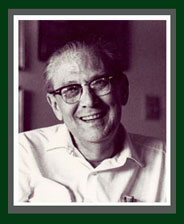Abraham Lilienfeld, MD, MPH
1920 — 1984

“Abe” Lilienfeld belongs in the Pantheon of CVD epidemiology, despite the absence of specific researches in CVD, for his major contributions to thinking about causal inference in the epidemiology of chronic diseases and for his unflagging and influential support of the CVD research and prevention enterprise. The latter was largely as advisor, consultant, editor, and public health activist, and as advocate in the 1970s for the threatened Framingham Study and in the 1980s for CVD surveillance and public policy on prevention. He was known as “Father of Contemporary Chronic Disease Epidemiology.”
Lilienfeld was born in New York City, son of a Galician rabbinical scholar whose family had left its substantial holdings in Germany when they immigrated to the U.S. in 1914. Reduced to poverty with Germany’s collapse, the family regrew its resources with a succession of candy stores with soda fountains. He was pushed into medicine by his family, was successful in pre-medicine at Johns Hopkins, but excluded by the small Jewish quota for its medical school and went to medical school in Albany, then Maryland, from which he graduated in 1944.
Unhappy in clinical medicine he entered the US Public Health Service in 1946, worked in tuberculosis control, and entered Hopkins for the MPH in 1948, where he met the leaders of epidemiology and statistics of the day. He then profited in his PHS assignments from his friendship with Morton Levin with whom he collaborated for some years on the epidemiology of cerebral palsy.
His relative by marriage, Jacob Yerushalmy, became a lifelong colleague in development of methods and concepts in chronic disease epidemiology, including criteria for causal inference from statistical associations, in record linkage for the study of child development, and in the reliability and validity of clinical observations. From his interest in statistics he became instrumental in introducing analysis of variance into the research activities of CDC and biostatistics and life table analysis into wide usage in epidemiology.
Due to his personal analysis and advocacy about the relation of cigarette smoking to lung cancer, appearing in The Nation in 1962, he was rendered “too partial” to be appointed to the Advisory Committee for the Surgeon General’s Report on Smoking and Health in 1963, but later was named staff director for the President’s Commission on Heart Disease, Cancer, and Stroke.
According to his epidemiologist son, David Lilienfeld, Abe was a strong advocate for public health. “The notion that researchers should not advocate on behalf of public health” was foreign to him. He viewed himself as a member of the public health community. We viewed him as the warm, involved, curious, effective counselor, innovator, and quiet leader that he was, always, but not long enough. He died suddenly after several premonitory events and one earlier defibrillation and resuscitation. It is not clear whether there is any comparably skilled navigator or firm hand on the tiller of epidemiology in the public health today. (HB)
Sources
“Abe and Yak.” David Lilienfeld. Epidemiology 18: 507, 2007
Memorium. Johns Hopkins Bloomberg School of Public Health 75th anniversary, 1991